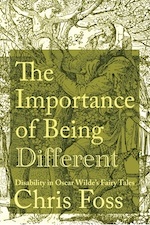Today, we are happy to bring you our conversation with Chris Foss, author of The Importance of Being Different: Disability in Oscar Wilde's Fairy Tales
What inspired you to write this book?
Wilde’s “The Birthday of the Infanta” first caught my eye as a completely compelling literary representation of disability. Then, as I began to look more closely, I realized that Wilde featured different bodies (bodies I came to conceive of as “disability-aligned”) across all nine of his fairy tales—especially also in “The Fisherman and His Soul,” “The Happy Prince,” “The Selfish Giant,” and “The Star-Child.” I decided this project would be a wonderful opportunity to bring together my two primary scholarly emphases, nineteenth-century British literature and disability studies.
What did you learn and what are you hoping readers will learn from your book?
The vital importance of being different, of course! For me, Wilde invites his readers not only to sympathize with, but to further identify with these different bodies. His fairy tales are far from simple or naïve stories; if you are unfamiliar with them, do not expect to find any traditional happily ever afters. Yet, though Oscar is more famous for his sparkling plays and his witty one-liners, or for his decadent Dorian and his stunning Salome, he also was a thoroughgoingly utopian thinker, as his tour de force literary criticism suggests. I want my readers to develop a deeper appreciation for this side to Wilde, which for me permeates his fairy tales in spite of all of the pain and suffering they contain.
What surprised you the most in the process of writing your book?
What surprised me the most was just how hard it is to write this sort of book! From drafting the chapters right down to generating the Index, the time commitment was intense. As my home institution, Mary Washington, emphasizes teaching over research and carries a typically large load of courses each semester, I have spent my career focusing on shorter projects such as conference presentations and book chapters/journal articles, which I feel like I pretty much had down pat by the time I turned to this monograph. I still ended up doing the majority of my writing during summers, but I definitely was pushed to learn new strategies for sustaining a significant focus throughout the academic year in spite of the demands of the classroom.
What’s your favorite anecdote from your book?
Originally, I had planned to write on all nine tales in some depth, and it was hard to let go of that goal for the book. When I eventually abandoned that plan for the current arrangement, which features four tales given full-chapter treatments and a fifth offered a decent section near the end of the Introduction, part of what reconciled me was a silly consolation. Like Wilde, I love playing with language and was pleased to sprinkle in my own dashes of fun whenever I could. My favorite instance of this is when I refer to the “tongue-in-beak delivery” of the bird who serves as primary narrator in “The Devoted Friend,” and when I realized I could keep that line I relaxed about the rest!
What’s next?
Literally just today I presented a conference paper on the little-known book Psychic Messages from Oscar Wilde by Hester Travers Smith at the Nineteenth-Century Studies Association’s annual conference, held this year in New Orleans. I also have a piece entitled “‘Natural interpreters of an important patois’: Sunaura Taylor, Dawn Prince-Hughes, and the Intersection of Animal Studies and Disability Studies” coming out as part of a volume from the Modern Language Association on neurodiversity. Lastly, I completed a Fall sabbatical for which I wrote an essay on former friend and colleague Claudia Emerson, the first Southern woman to win the Pulitzer Prize in Poetry; the piece analyzes her literary representation of the lived experience of cancer in her posthumous volume Impossible Bottle.





